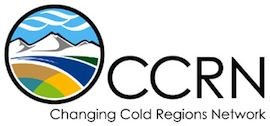Theme C: Upscaling for Improved Atmospheric Modelling and River Basin-Scale Prediction
Theme Lead: Howard Wheater (University of Saskatchewan)
Overview
Theme C builds on the insights from the WECC observations and fine-scale modelling (Themes A and B) to develop and test improved models for large scale application, both as land surface schemes within weather forecasting and climate models, and as large-scale hydrological models that can be used to analyze and predict change at large river basin scale. The application of these models, to address impacts of change on river flows and land-atmosphere feedbacks, is in Theme D. The key science question for this Theme is: how can our large-scale predictive models be improved to better account for the changing Earth system and its atmospheric feedbacks?
Work Package Descriptions
C1 Algorithm Development for Weather and Large-Scale Hydrological Models
This work package focuses on the development of improved algorithms for land surface models that are applicable at large scales, i.e. that can be used to improve the capability of climate and weather forecasting models and large-scale hydrological models. This requires simplified representation of the land surface and its processes. The challenge is to provide appropriate model schemes that capture the key processes in a way that effectively represents the large scale response. Hence C1 will test existing schemes to evaluate current levels of performance and associated strengths and weaknesses, and use high resolution modelling to inform the development of new up-scaled parameterizations. This requires new research to investigate the scale-dependence of processes, and systems analysis to examine process and parameter uncertainty across scales, including trade-offs between different model outputs (e.g. runoff and land-atmosphere fluxes). A key focus will be on ECCC models, in particular GEM/MESH, however, comparative analysis with other models is proposed. This will include WRF and WRF-HYDRO, in collaboration with NCAR, and the UK JULES model.
Description of Activities & Milestones:
C1.1 Testing of existing land surface schemes using WECC data (anticipated completion by April, 2015): Testing and comparative analysis of ECCC's CLASS and MESH algorithms (including Watflood), NCAR's WRF and WRF-Hydro algorithms, using WECC and meso-scale data.
C1.2 Development and testing of improved algorithms at WECC-scale (anticipated completion by April, 2016): Development and testing of new upscaled parameterizations for alpine, borel forest, tundra and prairie environments, including glacier, snow, lake and groundwater processes, using assimilation of spatial measurements and fine-scale modelling.
C2 Large Basin-Scale Application and Testing of Weather, Climate and Large-Scale Hydrological Models, Including Verification and Assimilation of Ground-Based Observations and Remotely Sensed Data
This work package involves basin-scale testing on a domain that includes the Saskatchewan and Mackenzie River basins, focusing on Earth system change and the potential for using streamflow, soil moisture and snow cover observations and other data sources to constrain model parameterizations. Decadal (historical) simulations of GEM/MESH will be performed to assess how well these models reproduce the observed change and variability over the CCRN domain, using a number of observational and reanalysis products, and by assessing how well the models can capture, e.g., relationships between low-frequency forcings and regional and local factors.
We will evaluate the potential for assimilation of remotely-sensed data. These include passive and active microwave observations and new datasets from AirMOSS and SMAP. Our prairie sites include geological lysimeters that provide a basis for measurement of integrated subsurface soil moisture and comparison with estimates from the satellite-based Gravity Recovery and Climate Experiment (GRACE) observing system. Data assimilation methods will be evaluated by downscaling satellite products using the improved high-resolution land surface modeling frameworks developed as part of the CCRN (CRHM and MESH). Evaluation of precipitation products will include CaPA (a combination of modelled and ground-based data), the new generation of EC dual-polarisation weather radars as they become available, and satellite based products (e.g., Precipitation Estimation from Remote Sensing Information using Artificial Neural Network (PERSIANN)) and the 2014 Global Precipitation Measurement (GPM) mission. An important consideration for the development of data assimilation tools is the accurate characterization of errors both in the data (including satellite products) and the hydrological models, and how these vary throughout the season in response to changes at the land surface. Model uncertainty analysis is proposed in which different sources of information (physics-based simulations, regionalised data and observations, with associated uncertainties) are used to constrain feasible distributions of model parameters. New research will address issues of spatial structure in the associated analysis of model and parameter uncertainty.
An important new development in large-scale modelling will be the incorporation into MESH of anthropogenic controls on river flows. The primary test-bed for this development will be the SaskRB.
Description of Activities:
C2.1 Development of MESH modelling framework for major basins (anticipated completion by April, 2015): Grid-based modelling frameworks will be developed for ECCC’s CLASS/MESH models for the Saskatchewan, Mackenzie and Peace-Athabasca River systems at 10km scale. Models will be tested using existing model elements, including design and testing of improved spatial discretization schemes. Where possible, comparison will be made with other models. Collaboration with NCAR is expected to deliver 4km resolution WRF simulations for the whole domain.
C2.2 Development and testing of assimilation methods (anticipated completion by April, 2016): Evaluate potential of ground-based & remote sensing data to improve model performance, including GPM, radar and reanalysis precipitation products (e.g. CaPA), SMAP soil moisture, GRACE and ground-based supporting data including multi-scale streamflow.
C2.3 Testing of improved land surface schemes at large basin-scale (anticipated completion by April, 2017): Test sensitivity of new algorithms for these rivers using decadal simulations, compare with high resolution WRF and NARCCAP simulations and evaluate skill to reproduce observed climate, hydrology and ecosystem variability and change.
